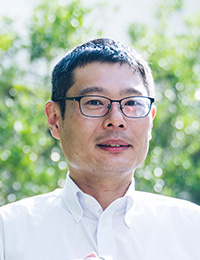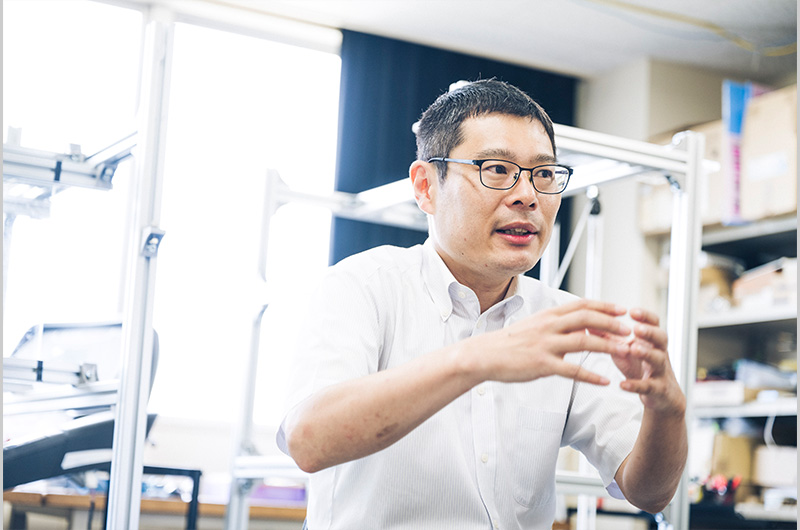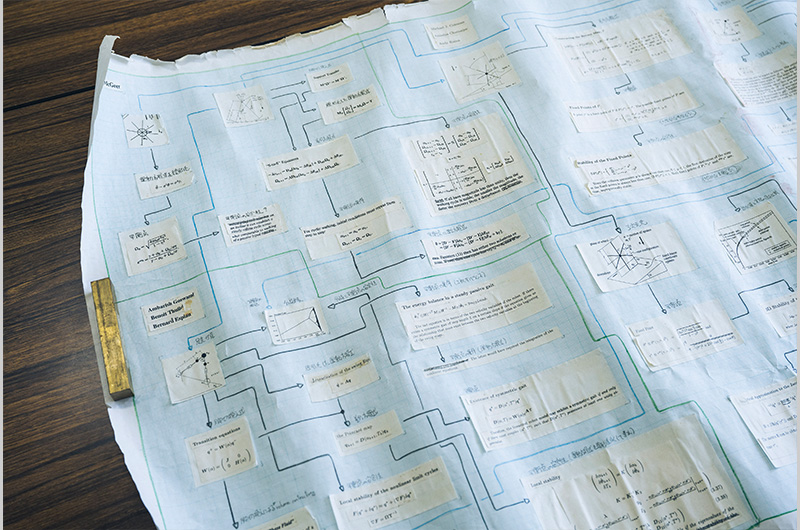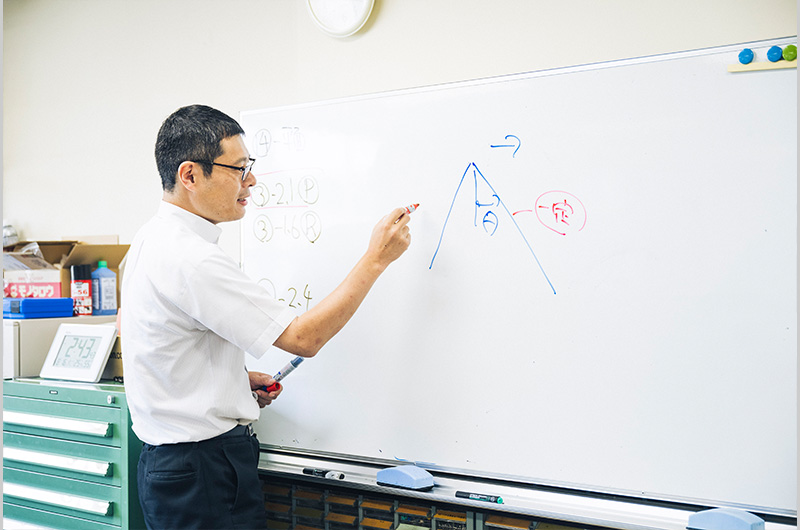
活動レポート


- 原理の追求に見る、SDGs達成のヒント -
![]()
![]()
![]()
![]()
![]()
![]()
![]()
![]()

帝京大学理工学部機械・精密システム工学科 准教授 池俣吉人
2006年 名古屋工業大学大学院博士後期課程修了。大学院で受動歩行ロボットとであい研究に取り組む。大学院修了後、名古屋工業大学特任助教となり、さらに受動歩行ロボットに関する研究に注力。2009年には、同大学のチームで開発した受動歩行ロボットが、13時間を超える連続歩行を実現しギネス世界記録™ に認定される。2011年より筑波大学大学院勤務。2012年より帝京大学理工学部に赴任。

学部4年生と大学院前期課程の時代、私が研究対象としていたのはロボットではありません。エンジンに興味があり、燃焼や熱関係の研究に携わりました。しかし、当時所属していた研究チームが一定の成果を達成したことから解散することとなりました。大学院後期課程の進学を考えているとき、隣の研究室(名古屋工業大学 教授 藤本英雄氏の研究チーム)が歩行ロボットの研究をしていることを知ったことが、この研究に携わるきっかけとなりました。受動歩行とは重力によって生じる位置エネルギーを、運動エネルギーに変換して歩行するシステムのことです。現在は下り坂=スロープでの歩行実験が主流となっています。電力やモーターといった動力を一切必要としないため、エネルギー効率が非常に高いのが特徴です。ロボットの形状は、人間で言えば腰から下の骨だけしかないような形状をしています。膝を曲げて歩く様子は、人間の動作そっくりなのですが、プログラミングなども必要としません。
受動歩行ロボットは、もともと航空工学の専門家であったカナダのタッド・マクギア博士によって1990年頃に誕生しました。今ではネットでマクギア博士の研究動画を見ることができますが、当時私が研究動画を見た時、極めて人間に近い動きに強く惹かれたことを覚えています。当時の受動歩行ロボットの研究はまだ黎明期で、ほんの数歩歩くと崩れ落ちるようなものでした。それでも、世界に与えたインパクトは計り知れません。以後、世界中で受動歩行ロボットの研究が本格化していきます。私も同様に、二足歩行の原理を追求する研究に没頭していきました。

現在、私たちが開発した受動歩行ロボットは数時間歩くことも苦ではありません。ここに至る道のりは困難を極めました。研究を始めたころは全く歩かず、数歩が限界でした。受動歩行自体が新しい分野ですから研究方法も手探りです。人間の歩行の様子を写真や動画に収めたり、必要と思われる数理モデルを片っ端から検証したり、世界中の論文を調べたりと、細部に至るまで手を尽くしました。同時期、私はコンピューターを用いた受動歩行のシミュレーションにも取り組んでいました。こちらでは有望と思われる2つのポイントが導き出されていました。1点目は「平衡点」を作り出すことです。ここでいう平衡点(リミットサイクルの断面点)とは、心臓や肺のように、繰り返し一定の周期で行われる運動のことです。歩行もまた、一定のリズムで足を出し続ける周期運動となっております。2点目は平衡点の「安定化」が重要であるということです。ここでいう安定化とは、多少の外的要因で乱れたとしても元に戻る性質のことです。たとえば下り坂にボールを転がすと加速していきますが、人間の場合、一歩ごとに加速しないように制御をかけて一定の速度で歩けるようにしています。さあ、これで研究の進むべき道が明らかになったのですが、どのようにしてその道を進めばよいのかわからない。こうした苦しい迷走状態が数年間続きました。
突破する気づきを与えてくれたのは、とある本の帯に書いてあった言葉でした。”複雑に考えるな、単純に考えろ”という趣旨の言葉です。実のところ、私たちは随分と複雑に考えていたのです。すぐに、数式や考え方を再検証し、複雑になった要素を丁寧に削ぎ落としていきました。課題も平衡点の生成と安定化の実現に集約させ、数式もシンプルにしていった結果、一つの数式にたどり着きました。同時に、重要だったことが「歩幅」の設定にあることに気づいたのです。それまでは、ロボットの足が稼働できる範囲の制限はなく、歩幅がバラバラでした。そこで新たに、左右の膝部分に同期機構を設置し、歩幅が一定になる制約を課して歩かせてみたところ、数十歩、数百歩と歩けるようになったのです。こうして2005年、平衡点の生成と安定化の原理を導くことに成功しました。
先駆者であるマクギア博士も、シンプルな構造物を用いた分析を積極的に行なっています。それは、博士が一定の速度で坂道を転がることのできる糸車のような構造体を作り上げたことでもわかります。極めてシンプルな構造ですが、突起状の部分が人間の足の役割を果たし、転がる力を毎回リセットできるため一定の速度で転がり続けることができます。原始的な機構で分析し、発想を集約していくことは時に大きな価値の発見につながります。もちろん、最終的なロボットの機構はより複雑なものですが、原理が判明すれば確実に前進できるのです。
しかしながら私たちのめざすゴールはまだ遥か先です。確かに受動歩行ロボットの安定化に成功しましたが、受動歩行ロボットはあくまでスロープで機能するものであり、水平面ではうまく歩きません。「人間が二足歩行する」原理は複合的な要素の集合体です。腰から下の骨組みしかない受動歩行ロボットも、大腿部の重さ、足の円弧形状、各接合部、同期機構など、理論や技術の集合体ですが、人間には上半身をはじめ筋肉や神経といったさらに多くの要素が存在しています。すべての要素を検証するには、途方もない労力が必要です。歩行の研究のヒントになるのではないかと、”走る”についても研究をしているところです。自分の体を用いて検証したり、運動選手の走りを映像におさめ、その動きを分析したり、地道な研究を積み重ねています。しかし最近、手応えを感じる成果がありました。”走る”を理解するためのシンプルな模型を作っているのですが、学生が手がけたものが大きなヒントを与えてくれたのです。一見すると、ずれた車輪がガタガタと動くようなアンバランスな構造体なのですが、実際に動かしてみると走る動作に近い。これによって、走る原理に到達する道が近づいたことを感じています。遠回りのように感じる思考と挑戦と分析を繰り返すことが、研究の最短距離なのです。

原理を追求していくことは、次の原理への入口を開くことでもあります。SDGsにおいても同じことが言えるのではないでしょうか。たとえば気候変動も複雑な原理の組み合わせで生じていると想定されますし、17のゴールの108の指標の追求には、原理を一つずつていねいに解明していく必要があると思われます。原理を理解できれば、改善のための方法を具現化することができるでしょうし、具現化したものを応用して次の原理解明に取り掛かれることでしょう。
私たちの研究は、高齢者や障がい者の歩行支援に応用されていますが、思いもよらない、より大きな活用につながる可能性もあります。実際、歩行支援器具の開発に携わった経験もありますし、歩行の負荷を軽減できることも実証済みですが、歩行の原理を知るというプロセスそのものが、別の学問やビジネスを飛躍的に発展させる可能性があります。私の究極の目的は、あくまで歩行の原理を明らかにすることです。しかし、それを理解するには物理学や医学といった先人たちが切り拓いた知恵が必要であり、さらにはシミュレーションや分析などに使用する機器類の高度化が欠かせません。さらにはロボットを構築する素材や加工技術が求められます。つまり、原理の解明の速度を上げていくことは科学の発達につながっていく可能性があるのです。そこには、SDGs的がめざす持続可能な社会の達成と類似の未来を描くことができます。原理を追求するプロセスで蓄積されたデータや知見は、文明を前進させる力強い歩みになりうるのだと考えています。